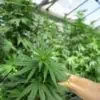TABLE OF CONTENTS
If you have plans to grow cannabis, it pays to take a look at all the unused spaces in your house that may be ideal to repurpose as a grow room. A basement filled with old and unwanted items may be an ideal space to grow if you take into consideration a few key needs.
In this article we'll discuss how to build a grow room in a basement. We'll take you through every step of the setup process to get you started cultivating cannabis in your unused basement space.
Pros and Cons
A fully set up grow room in your basement can provide proper odor control and noise dampening so that no one in floors above is the wiser. This can help if you plan to keep your garden secure and private.
Generally, basements are cooler than the floors above. A cool basement makes temperature control more manageable if you are worried about heat from the grow lights.
In terms of venting, basements can be discreetly vented and since they usually have no windows, it can keep all the light from your grow lights inside without leaking in outside light either, which is especially helpful to maintain light cycles during the vegetative and flowering stage.
If you create a sealed grow room design in your basement, you can protect your garden environment from pests, such as spider mites, aphids, fungus gnats, and many more unwanted pests that can eat your plants and make them weaker.
The nature of basements provides a secure and private area where thieves and law enforcement are not able to see your growing plants.
When setting up a basement grow, you must also consider its downsides.
- Since basements can be cooler, the cooler temperatures can negatively affect marijuana plant roots, although you can invest in the heating mat to provide some heating.
- Basements may not be as private or secure when you need to fix electrical panels, water heaters, or other equipment used in your home housed in your basement.
- If your basement is unfinished, you will have to invest heavily in electrical wiring, plumbing, venting, grow room insulation, drywall, and grow room wall panels.
- You will need to consider the safety of walking up and down the basement stairs while carrying heavy items such as buckets of water, lights, and other growing essentials.
- If you don't have the proper ventilation or climate control, you can increase your risk of creating a mold and mildew infestation.
- You may need to invest in a sump pump and a dehumidifier to handle groundwater flooding and excess humidity.
How to Build a Grow Room in a Basement
Now that you know what to expect when building a grow room in your basement, it's time to consider the main requirements needed for an indoor grow area in general.
Here's what you'll need:
- Plenty of space to fit the plants you intend to grow
- Enough electricity to handle the equipment used in the grow rooms
- Lighting for your plants
- A continuous airflow system removes old air and replaces it with fresh air
- An HVAC system to create a climate-controlled environment for your cannabis plants
- Separate areas for vegetative and flowering plants to grow if you plan to grow year-round
Space
Even though you have a big basement, you need to give your plants plenty of space to breathe and have good airflow while also giving you space to move around and care for your plants. Your plants may look smaller in the beginning but they can grow tall and big and need plenty of space to grow vertically and horizontally.
Heat and Light
Your room should be able to accommodate the light cycles of vegetative and flowering periods. It needs to be lit during one part of the day and completely dark in another. If you have any windows in your basement, you can use a sheet of foam to the exact size of your window and use caulk or tape to seal it.
Vegetative and Flowering Room
Because vegetative plants and flowering plants require different lighting requirements, you need two separate growing spaces, a vegetative room and a flowering room, if you plan to grow two types of plants in the same basement.
Generally, a vegetative room can be much smaller than the flowering room. Flowering rooms can be four times bigger than the vegetative room. Grow tents are an excellent choice to create separate rooms in your basement.
If you plan to complete your entire operation in your basement from planting to drying and curing, you may need separate rooms. For instance, a drying tent can be set up to dry your plants after harvesting them.
CO2 Enrichment
Indoor growers can choose to increase the CO2 levels inside their growing space. There are two main ways to do so:
- A CO2 generator uses propane or natural gas to produce CO2. This may increase the temperature in your grow room.
- Bottled CO2 is easier to use although the tanks can be expensive and heavy.
When using a CO2 enrichment device, consider these tips:
- Use a CO2 ppm controller to control CO2 levels.
- Use CO2 when the lights are on since cannabis plants do not absorb CO2 when it is dark.
- Release the CO2 near the ceiling since CO2 is heavier than air.
Cleanliness
Once you've decided to grow in your basement, it's time to clean everything from the area, even before you build individual rooms for vegetative and flowering plants in your basement. Giving your basement a deep clean can help prevent a pest infestation later on.
Ensure that you have an area near the door of your grow room where you can store fresh clothes before entering your grow room. This helps reduce the risk of introducing pests into your garden. You can also use this area to keep sanitized tools and other cleaning equipment such as mops and vacuums.
Flooring
We recommend concrete flooring with drains for your basement grow. Ideally, you will be growing marijuana in a basement without carpet. But, if you can't remove the carpet or don’t have concrete, you can use a floor covering such as thick plastic to protect the flooring from moisture.

Air Flow
Providing your plants with the proper airflow and fresh air can be accomplished with in-line duct fans. Setting up a duct system can help give your plants fresh carbon dioxide and remove the stale air.
When setting up your ventilation system, make sure you have the same diameter size carbon filter, ducting, and fans. When buying fans, look into the air throw to ensure that it can handle cooling the size of your room, or else you may need another fan.
When shopping for fans, you need to calculate how much air exchange you need for your basement grow room. Generally, an indoor grow room needs at least one exchange of air every 5 minutes. You can refer to the cubic feet per minute (CFM) measurement of the equipment.
If you want to calculate CFM of your exhaust fans, you must first determine the volume of your room. Measure the length, height, and width of the basement and multiply this number to gain the volume of cubic feet.
Width x height x length = volume of cubic feet
To determine the CFM rating necessary for your basement, divide the basement volume by 5 minutes (the minimum air exchange needed).
Volume of cubic feet ÷ 5 = CFM
CFM requirements for your basement can be affected by the type of lighting you have, its air cooling capabilities, CO2 enrichment, carbon filter use, and your ambient climate. Each of these can add between 5 to 20% of CFM requirements each to your CFM base.
We recommend horizontal airflow (HAF) fans to circulate the air in your room. Use multiple fans to spread the cooler air properly.
An inlet (supply) fan provides fresh air to the room. Ideally, it should draw air from a temperature and humidity-controlled source. Make sure you have all your air supply from your inlet fans matches the volume of air being exhausted.
Exhaust fans should be installed above your plants to pull up cool air from the floor, so it can properly circulate it through your canopy.
When setting up your oscillating fan, avoid blowing air in a single spot since it can cause windburn on the plants. We recommend installing duct fans for better results.
Odor control carbon filters can help minimize the smell of your garden. Before installing your carbon filter, make sure to invest in one that can handle your room’s CFM.
Water Source
Marijuana plants require a lot of water to grow healthy. If you're growing in the basement, make sure you have a water outlet nearby , so you can have an easier time watering your plants. It can be a pain to walk around with heavy buckets of water up and down the stairs.
In basements, if you have a water heater or washer, you may be able to attach a water manifold with an on and off valve to the hot and cold water hose bib.
If you'll be using a hose to water your plants, you can invest in a watering wand and a flexible hose adapter to extend your reach and make watering easier.
Electrical Wiring
It is important to provide your indoor grow room basement with the right amount of electricity. Generally, the electrical infrastructure you have right now is not capable of handling a grow room setup. All of the equipment such as lighting, HVAC system, and more devices can overload your circuits.
For best results, we recommend hiring a professional electrician to help you set up your electrical wiring. A licensed electrician can ensure that your grow room wiring is capable of handling your equipment needs.
It is helpful to know your breaker box capacity for each outlet to ensure you do not go over it. A licensed electrician can help you ensure you have enough support for all your humidifiers, fans, lights, and more.
If you'll be working with electrical wiring, here are a few basic terms you should know:
- Amperes (amps) is a term that is used to measure the electrical current.
- Voltage is used as a measurement to describe the electrical potential of a connection.
Higher voltage means you need less amperage and vice versa. If you need to calculate how much electricity you need, use this formula:
watts/volts = amps
Safety tip: For maximum fire safety, make sure you have a fire extinguisher nearby in case an improper electrical setup starts a fire.

Lights
All indoor cannabis gardens need the right grow lights to give your plants the ability to grow healthy. When you purchase your lights, follow the instructions from the light manufacturer to set them up and hang them.
You may need to do some trial and error on the proper distance between your lights and your plants. If the plants begin to show signs of bleaching, you can move the lights up higher but if the plants are okay you can move the lights a bit closer until you see signs of bleaching.
Grow tent material can use a reflective material inside, but if you are not using tents, you can invest in other methods to improve the reflectivity of your lights and enhance their efficiency. Flat white paint is a reflective material (much better than glossy white).
You can also install other reflective material in your grow space such as wall panels on your walls. Mylar and panda plastic are options to consider if you want an alternative to flat white paint.
Temperature and Humidity
Basements tend to be considerably cooler than upper floors, which is especially helpful during the summer. In addition, the heat from the grow lights can be controlled much easier in the basement due to the cooler temperatures.
“
There are over 300,000 jobs in the cannabis industry. CTU trained me for one of them!

Makes $24.50 @ THC +
Invest in a thermometer and hygrometer to monitor the temperature and relative humidity (RH), respectively. RH refers to the amount of moisture in the air. We suggest investing in multiple thermometers and hygrometers strategically placed in various locations of your grow room.
In terms of heating and air conditioning, we recommend keeping your basement grow room at 75º F. You can add a space heater if your basement is regularly below 70º F or an air conditioner if it is regularly above 80º F.
A ductless mini-split air conditioner is a good option that helps blow stale and warm air outside of your grow room over cold evaporator coils.
In terms of humidity, you can use a humidifier if your basement grow room’s RH starts to drop below ideal levels. Make sure to invest in a humidifier that can handle the size of your grow room.
A dehumidifier can help if your grow room RH levels are higher than ideal.
Enroll at CTU, Become a Master Cannabis Grower
Cannabis Training University is your number one source for a complete cannabis education. Learn basic and advanced cultivation techniques from top growers. Our cannabis courses are available completely online for an affordable fee.
Our grow room cannabis cultivation course can show you how to grow in a variety of places such as a garage, closet, attic, windowsill, greenhouse, and other indoor rooms and spaces.
Start learning how to be a master grower today at the top cannabis horticulture school.

Luis Cordova
Luis Cordova is a distinguished author, and renowned expert in cannabis cultivation, who possesses a Master's degree in Plant Biotechnology and Pharmaceutical Science. As a valued contributor to highly esteemed publications such as Cannabis Training University and Maximum Yield Magazine, Luis has emerged as a trusted source of guidance and knowledge in the cannabis industry. Having written thousands of informative articles, Luis is widely recognized for his comprehensive expertise on cultivating cannabis, both indoors and outdoors.












 Jeff was involved in an accident where he endured a traumatic brain injury. He had a week-long stay in ICU where brain surgeons
Jeff was involved in an accident where he endured a traumatic brain injury. He had a week-long stay in ICU where brain surgeons  100% risk free money back guarantee within 48 hours after purchase if student has not completed any of the courses or exams.
100% risk free money back guarantee within 48 hours after purchase if student has not completed any of the courses or exams.